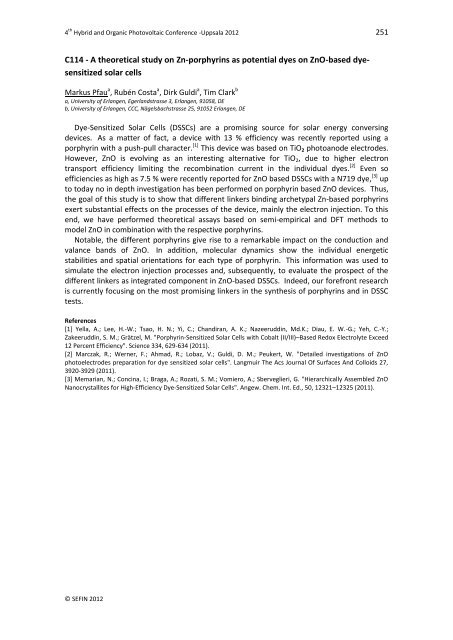HOPV12 - Blogs
HOPV12 - Blogs
HOPV12 - Blogs
Create successful ePaper yourself
Turn your PDF publications into a flip-book with our unique Google optimized e-Paper software.
4 th Hybrid and Organic Photovoltaic Conference -Uppsala 2012 251<br />
C114 - A theoretical study on Zn-porphyrins as potential dyes on ZnO-based dyesensitized<br />
solar cells<br />
Markus Pfau a , Rubén Costa a , Dirk Guldi a , Tim Clark b<br />
a, University of Erlangen, Egerlandstrasse 3, Erlangen, 91058, DE<br />
b, University of Erlangen, CCC, Nägelsbachstrasse 25, 91052 Erlangen, DE<br />
Dye-Sensitized Solar Cells (DSSCs) are a promising source for solar energy conversing<br />
devices. As a matter of fact, a device with 13 % efficiency was recently reported using a<br />
porphyrin with a push-pull character. [1] This device was based on TiO2 photoanode electrodes.<br />
However, ZnO is evolving as an interesting alternative for TiO2, due to higher electron<br />
transport efficiency limiting the recombination current in the individual dyes. [2] Even so<br />
efficiencies as high as 7.5 % were recently reported for ZnO based DSSCs with a N719 dye, [3] up<br />
to today no in depth investigation has been performed on porphyrin based ZnO devices. Thus,<br />
the goal of this study is to show that different linkers binding archetypal Zn-based porphyrins<br />
exert substantial effects on the processes of the device, mainly the electron injection. To this<br />
end, we have performed theoretical assays based on semi-empirical and DFT methods to<br />
model ZnO in combination with the respective porphyrins.<br />
Notable, the different porphyrins give rise to a remarkable impact on the conduction and<br />
valance bands of ZnO. In addition, molecular dynamics show the individual energetic<br />
stabilities and spatial orientations for each type of porphyrin. This information was used to<br />
simulate the electron injection processes and, subsequently, to evaluate the prospect of the<br />
different linkers as integrated component in ZnO-based DSSCs. Indeed, our forefront research<br />
is currently focusing on the most promising linkers in the synthesis of porphyrins and in DSSC<br />
tests.<br />
References<br />
[1] Yella, A.; Lee, H.-W.; Tsao, H. N.; Yi, C.; Chandiran, A. K.; Nazeeruddin, Md.K.; Diau, E. W.-G.; Yeh, C.-Y.;<br />
Zakeeruddin, S. M.; Grätzel, M. "Porphyrin-Sensitized Solar Cells with Cobalt (II/III)–Based Redox Electrolyte Exceed<br />
12 Percent Efficiency". Science 334, 629-634 (2011).<br />
[2] Marczak, R.; Werner, F.; Ahmad, R.; Lobaz, V.; Guldi, D. M.; Peukert, W. "Detailed investigations of ZnO<br />
photoelectrodes preparation for dye sensitized solar cells". Langmuir The Acs Journal Of Surfaces And Colloids 27,<br />
3920-3929 (2011).<br />
[3] Memarian, N.; Concina, I.; Braga, A.; Rozati, S. M.; Vomiero, A.; Sberveglieri, G. "Hierarchically Assembled ZnO<br />
Nanocrystallites for High-Efficiency Dye-Sensitized Solar Cells". Angew. Chem. Int. Ed., 50, 12321–12325 (2011).<br />
© SEFIN 2012


